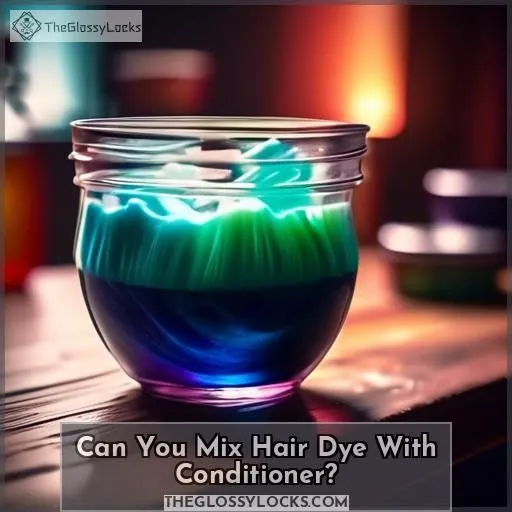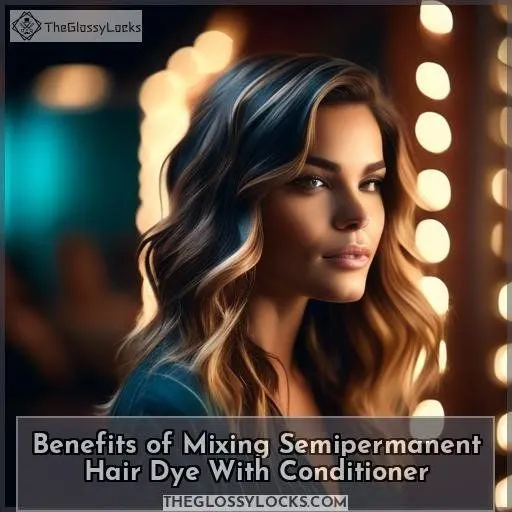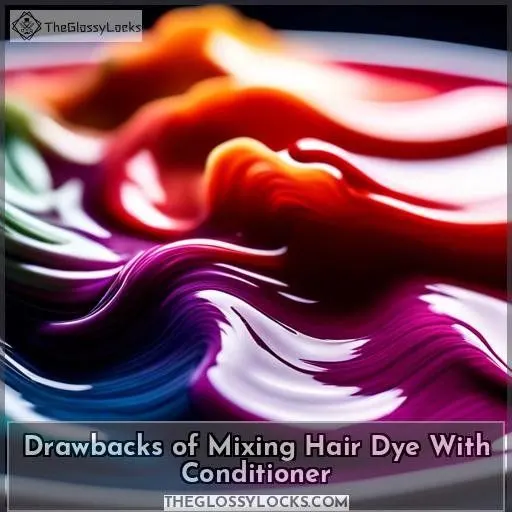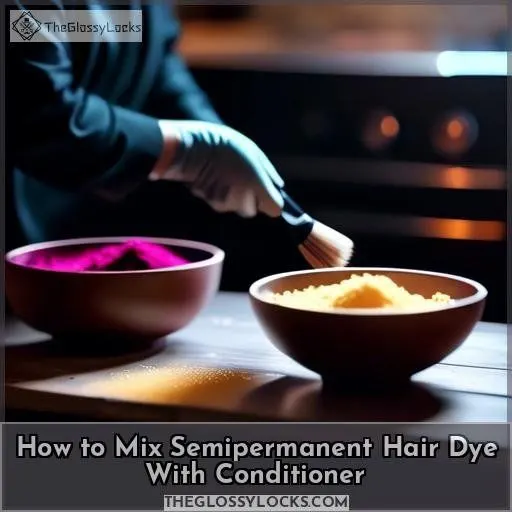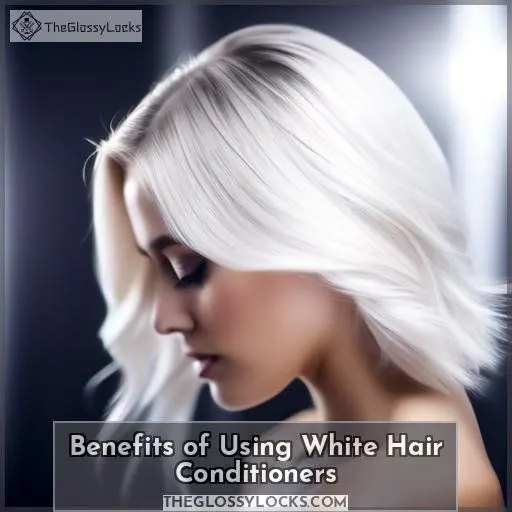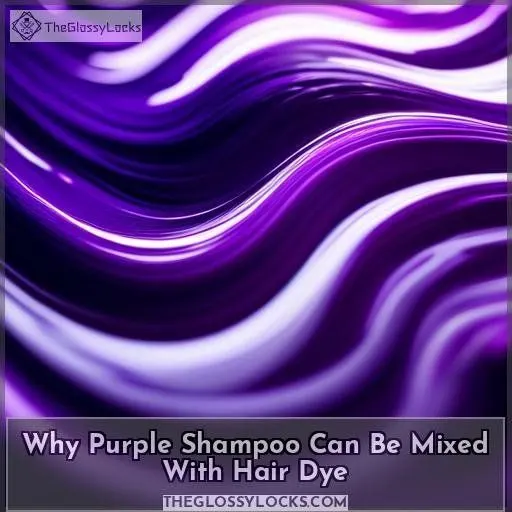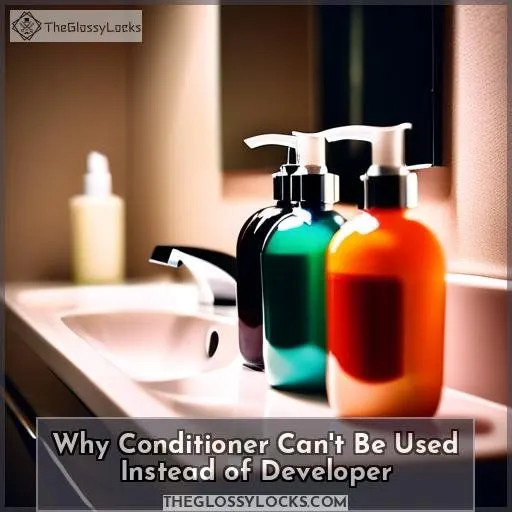This site is supported by our readers. We may earn a commission, at no cost to you, if you purchase through links.
Yes, you can mix semipermanent hair dye with conditioner.
It enhances your natural color, adds vibrancy, and deeply conditions your hair.
Plus, it prevents scalp buildup and uneven color.
For best results, use white conditioner to dilute the dye strength and provide extra brightening.
You can also mix purple shampoo with hair dye to neutralize unwanted warmth or yellow/brassy tones.
Mixing hair dye with conditioner offers a gentle way to refresh your color and nourish your hair.
Table Of Contents
- Key Takeaways
- Can You Mix Hair Dye With Conditioner Shampoo?
- Benefits of Mixing Semipermanent Hair Dye With Conditioner
- Drawbacks of Mixing Hair Dye With Conditioner
- How to Mix Semipermanent Hair Dye With Conditioner
- Benefits of Using White Hair Conditioners
- Why Purple Shampoo Can Be Mixed With Hair Dye
- Why Conditioner Can’t Be Used Instead of Developer
- Frequently Asked Questions (FAQs)
- Conclusion
Key Takeaways
- Mixing semipermanent hair dye with conditioner enhances natural color, adds vibrancy, and deeply conditions hair.
- White conditioner can dilute dye strength and provide extra brightening, while purple shampoo can neutralize unwanted warmth.
- Drawbacks include scalp buildup, weakened hair, uneven color, and muted vibrancy.
- Conditioner cannot be used instead of developer, as it seals and protects hair rather than opening cuticles for color penetration.
Can You Mix Hair Dye With Conditioner Shampoo?
Yes, you can mix hair dye with conditioner. This will dilute the dye and make it less harsh on your hair.
Benefits of Mixing Semipermanent Hair Dye With Conditioner
Mixing semipermanent hair dye with conditioner offers subtle color enhancement, ensuring long-lasting vibrancy and even distribution. It also moisturizes and conditions your hair during the coloring process, preventing oversaturation and uneven color.
Natural Color Enhancement
Mixing semipermanent hair dye with conditioner is a fantastic trick for enhancing your natural color. You can create subtle highlights, tone down brassiness, or even touch up your roots without damaging your hair.
The conditioner acts as a protective barrier, preventing the dye from penetrating too deeply and causing damage. It also helps to distribute the color evenly, giving you a natural-looking result.
Long-Lasting Vibrancy
Mixing semipermanent hair dye with conditioner ensures long-lasting, even color. The conditioner seals in the dye molecules, preventing them from washing out quickly. This results in a subtle, natural-looking color that lasts for several washes.
- Conditioner Seals in Dye: The conditioner creates a barrier between the hair and the dye, preventing the dye from penetrating too deeply. This helps to prevent oversaturation and uneven color.
- Long-Lasting Vibrancy: The conditioner also helps to keep the hair dye from fading. The moisturizing ingredients in the conditioner help to keep the hair healthy and vibrant, which helps to prevent the color from looking dull or washed out.
- Subtle, Natural-Looking Color: Mixing hair dye with conditioner creates a subtle, natural-looking color that’s perfect for those who want to enhance their natural hair color or cover up gray hairs. The conditioner helps to blend the dye with the natural color of the hair, resulting in a seamless, even finish.
Protective Hydration
Mixing semipermanent hair dye with conditioner doesn’t just enhance color – it’s a hydration haven for your scalp. The conditioner’s nourishing embrace prevents dryness, enveloping your hair in a protective layer that shields it from environmental aggressors like UV rays.
Here’s a quick breakdown of its benefits:
| Benefit | How it Helps |
|---|---|
| Moisturizes Scalp | Soothes and prevents irritation |
| Prevents Dryness | Keeps hair soft, supple, and manageable |
| Nourishes Hair | Infuses strands with essential nutrients |
| Enhances Color | Preserves vibrancy and prevents fading |
| UV Protection | Safeguards hair from sun damage |
Drawbacks of Mixing Hair Dye With Conditioner
Mixing hair dye with conditioner, while offering benefits, also poses a few pitfalls you should be aware of. One potential drawback is scalp buildup. Conditioner, when mixed with dye, can leave a residue on your scalp. This buildup can clog hair follicles, leading to scalp irritation and even hair loss.
Weakened hair is another potential issue. Conditioner, while nourishing, can also weaken hair strands when mixed with dye. This is because the chemicals in hair dye can damage the hair’s protein structure, making it more prone to breakage. This can lead to split ends, frizz, and overall hair damage.
Uneven color is another potential problem. Mixing hair dye with conditioner can make it difficult to achieve an even color distribution. This is because conditioner can act as a barrier between the hair and the dye, preventing the dye from penetrating evenly. As a result, you may end up with streaks or patches of uneven color.
Muted vibrancy is another potential drawback. Conditioner can dilute the color of hair dye, resulting in a less vibrant and intense color. This is because conditioner contains ingredients that can reduce the potency of the dye, leading to a less noticeable color change.
Removal difficulty is another potential issue. Mixing hair dye with conditioner can make it more difficult to remove the dye later on. This is because conditioner can seal the dye into the hair shaft, making it more resistant to fading. As a result, you may have to use harsh chemicals or multiple treatments to remove the dye completely.
How to Mix Semipermanent Hair Dye With Conditioner
- Use white conditioner to dilute dye strength and prevent scalp sensitivity.
- Combine 1 tbsp of hair dye with 1/3 cup of conditioner.
- Mix thoroughly until smooth and creamy.
- Apply evenly from roots to ends, ensuring uniform application.
- Leave on for 15-30 minutes, depending on desired color intensity.
Benefits of Using White Hair Conditioners
White hair conditioners can lighten and brighten your hair, as they contain hydrogen peroxide or bleach that strips away natural hair tint, leaving it looking bright and youthful. If your hair is experiencing brassy or yellow tones, white conditioners can correct these unwanted hues.
Benefits of White Conditioners
White conditioners contain bleaching agents like hydrogen peroxide, which strip away natural hair pigments. This lightening effect brightens hair, leaving it looking youthful and vibrant.
If your hair has unwanted brassy or yellow tones, white conditioners can help correct them. The bleaching agents in these conditioners counteract the warm pigments, resulting in a cooler, more natural-looking color.
White conditioners are particularly beneficial for those with dark hair who want to lighten it without causing damage. The bleaching agents in these conditioners are gentler than those found in traditional hair dyes, so they won’t damage your hair’s structure.
Lightening and Brightening Hair
White conditioners are your secret weapon for achieving brighter, blonder locks. Infused with hydrogen peroxide or bleach, these conditioners gently lighten and brighten your hair, leaving it looking radiant and youthful.
They’re especially effective at banishing brassy or yellow tones, giving you the cool, platinum blonde you crave. Plus, they’re a great way to maintain your blonde color between salon visits.
Correcting Brassy/Yellow Tones
White hair conditioners have a secret superpower: they’re brilliant at neutralizing unwanted brassy or yellow tones. By stripping away your hair’s natural tint, they create a clean canvas for color correction. So, if you’re seeking icy blonde or vibrant reds, start with a white conditioner. Just remember, it’s not a permanent fix, but it can dramatically improve the vibrancy and longevity of your hair color.
To correct brassy tones, mix equal parts purple shampoo and conditioner. Apply it to damp hair and leave it on for 5-10 minutes. Rinse thoroughly and follow with your regular conditioner. You can repeat this process as needed to maintain your desired color.
Why Purple Shampoo Can Be Mixed With Hair Dye
Purple shampoo, a color-correcting lifesaver, can be mixed with hair dye to neutralize those pesky brassy or yellow tones that haunt your hair. It’s like a magic wand for banishing color woes!
- Brass Be Gone: Purple shampoo contains violet pigments that counteract unwanted warmth, leaving you with cool, refreshed locks.
- Yellow, Yellow, Go Away: It’s not just brass that purple shampoo targets. It also tackles those stubborn yellow tones, bringing out the vibrancy of your hair color.
- Color Correction Made Easy: Mixing purple shampoo with hair dye is an effortless way to correct color mishaps or simply enhance your current shade. It’s like having a colorist at your fingertips!
Why Conditioner Can’t Be Used Instead of Developer
Developer is the secret weapon in transforming your hair color. It’s like a magic potion that opens up your hair cuticles, allowing the color to penetrate deeply and lock in vibrancy. Conditioner, on the other hand, is a nurturing balm that seals and protects your hair, keeping it soft and supple. These two hair heroes play very different roles, and while conditioner can enhance your color, it can’t replace developer.
Think of it this way: developer is the key that unlocks the door to color transformation, while conditioner is the guardian that keeps your hair healthy and radiant. Swapping one for the other is like trying to build a house with only a lock or a key – it simply won’t work.
Using conditioner instead of developer might seem like a tempting shortcut to vibrant hair, but it’s a path fraught with potential pitfalls. Developer-free hair color may not penetrate as deeply, resulting in a lackluster hue that fades quickly. Worse still, it could damage your hair, leaving it dry, brittle, and prone to breakage.
Frequently Asked Questions (FAQs)
Can conditioner damage hair?
Conditioner won’t wreck your hair if you use it right. Just don’t overdo it or skip the rinse—unless you’re going for the greasy, lifeless look.
How often should I use conditioner?
Imagine your hair as a thirsty traveler in a desert, conditioner is its oasis. You should use conditioner every time you shampoo to keep your hair hydrated, shiny, and as lively as a spring day.
What is the difference between semipermanent and permanent hair dye?
Permanent hair dye and semi-permanent hair dye are two different types of hair color treatments. Permanent hair dye enters the cortex of strands, altering their structure and color indefinitely, while semi-permanent hair dye simply sits on the hair’s surface to enhance shine, tone hair, and refresh color, gradually fading over time.
Can I use purple shampoo on non-blonde hair?
You might be wondering, “Can I use purple shampoo on non-blonde hair?” The answer is yes! Purple shampoo can be used on any hair color to correct brassy or yellow tones. Just be sure to use it sparingly, as it can be drying.
How do I correct brassy hair?
Correct brassy tones with purple shampoo, a color-correcting solution that neutralizes unwanted yellow hues. Its violet pigments counteract the brassiness, restoring your hair to its natural radiance.
Conclusion
Mixing semipermanent hair dye with conditioner is a clever way to refresh your color while pampering your locks. So, don’t let anyone tell you it’s a no-no. Embrace this hair-coloring hack and enjoy vibrant, healthy tresses.

